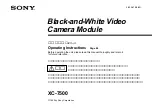
– 27 –
Adjustment procedures
Results of Improper adjustment
1. Changing the longitudinal motion of the looper
(1) Remove 10 setscrews
❶
in bed top cover and remove the cov-
er.
* The position where engraved marker line
E
on looper driving
arm
❷
aligns with engraved marker line
F
on looper avoid pin
❹
is the standard.
(2) When increasing the longitudinal motion of the looper, loosen
nut
❸
and adjust so that engraved marker line
F
on looper
avoid pin
❹
is in the direction
B
from engraved marker line
E
.
(3) When decreasing the longitudinal motion of the looper, loosen
nut
❸
and adjust so that engraved marker line
F
on looper
avoid pin
❹
is in the direction
A
from engraved marker line
E
.
* Perform the adjustment in accordance with the needle used.
(Caution) After adjusting the longitudinal motion of the looper,
move the looper holder and re-adjust the longitudinal
position of the needle and the looper. (Refer to "(9)
Returning amount of the looper.)
2. Changing the locus of the looper
(1) Loosen two setscrews
❻
in the cam and turn looper longitudi-
nal motion eccentric cam
❺
to change the timing.
When turning in the direction
C
, the timing is advanced, and in
the direction
D
, the timing is retarded.
(Caution) It is possible to change the locus of the looper. How-
ever, do not excessively change it from the standard
position (within the range of the groove width of
notch
H
on the looper driving shaft).
In addition, check the contact of the top end of left
needle with the back of the looper after changing the
motion locus.
◦ When the longitudinal motion of
the looper is small, the rate that
needle touches the back of the
looper is increased and blunt
needle tip will be caused.
◦ When the longitudinal motion of
the looper is large, the clearance
provided between the needle
and the back of the looper is
increased and stitch skipping at
the time of returning of the loop-
er will be caused.
◦ When the timing is retarded,
stitch skipping is apt to occur at
the time of going of the looper,
and especially the clearance
provided between the looper and
the left needle is widened. Nee-
dle strongly touches the back of
the looper and blunt needle tip
will be caused.
◦ When the timing is advanced,
stitch skipping is apt to occur at
the time of returning of the loop-
er.
Chain-off thread does not come
out smoothly.
◦ When removing the top cover for
adjustment or the like, sealant is
peeled off. As a result, oil leak-
age will be caused.
















































